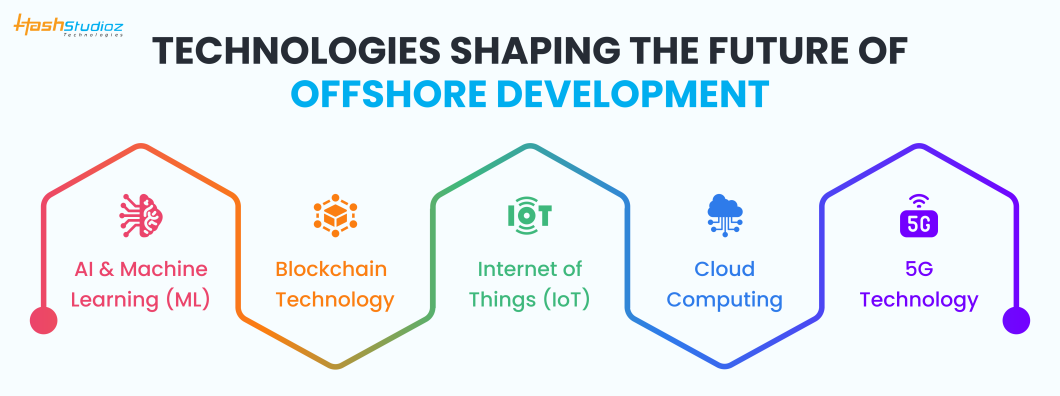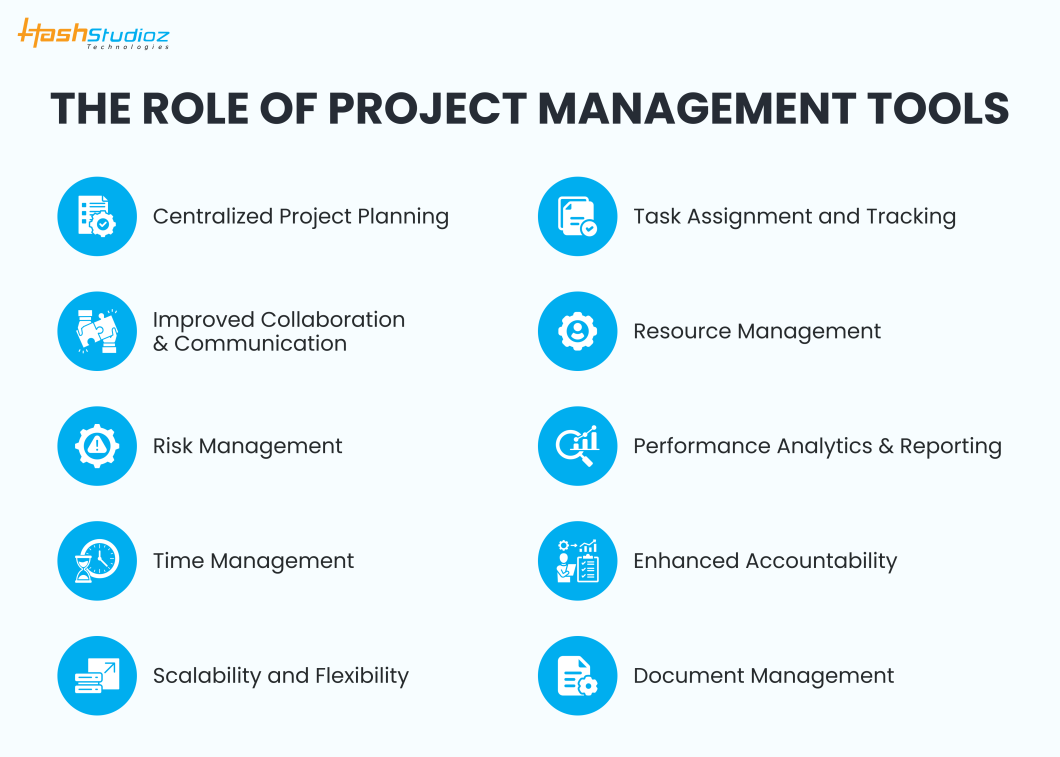Offshore development has become a critical strategy for businesses worldwide. Companies leverage offshore development centers (ODCs) and offshore software development teams to reduce costs, access global talent, and accelerate time-to-market. As technology advances and business needs shift, the future of offshore development will be shaped by several emerging trends and technologies.
Table of Contents
- Introduction to Offshore Development
- 2. Emerging Trends in Offshore Development
- 3. Technologies Shaping the Future of Offshore Development
- 4. The Future of Offshore Development Centers
- 5. Key Benefits of Offshore Development
- 6. The Role of Project Management Tools
- 7. Challenges to Consider
- 8. Choose HashStudioz for Your Offshore Development Needs
- 9. Why HashStudioz?
- 10. How HashStudioz Can Help You
- Conclusion
Introduction to Offshore Development
What is Offshore Development?
Offshore development refers to the practice of outsourcing software development tasks to teams located in different countries. This approach allows companies to tap into a global pool of talent, reduce operational costs, and focus on core business functions. An offshore development center (ODC) is a dedicated team or facility that a company sets up in another country to handle specific software development tasks.
The Current State of Offshore Development
In recent years, offshore development has become a popular choice for businesses of all sizes. According to a report by Statista, the global market for IT outsourcing, including offshore development, was valued at $66.5 billion in 2022 and is expected to grow steadily. Countries like India, Ukraine, and the Philippines are top destinations for offshore software development due to their skilled labor, cost advantages, and robust IT infrastructure.
2. Emerging Trends in Offshore Development
1. Increased Focus on Cybersecurity
As cyber threats become more sophisticated, businesses are prioritizing cybersecurity in their offshore development strategies. Offshore software development teams must adhere to strict security protocols to protect sensitive data. Companies implement advanced security measures such as end-to-end encryption, multi-factor authentication, and regular security audits.
2. Shift Toward Agile and DevOps Practices
Agile methodologies and DevOps practices are becoming standard in offshore development. These approaches promote collaboration, flexibility, and continuous delivery, aligning offshore teams with the dynamic needs of businesses. A McKinsey study found that companies adopting Agile and DevOps practices saw a 20-30% increase in productivity and a 60% improvement in customer satisfaction.
3. Rise of AI and Automation
Artificial intelligence (AI) and automation are transforming offshore development. AI-powered tools automate repetitive tasks, enhance code quality, and optimize project management. For example, AI-driven code review tools identify bugs and vulnerabilities faster than manual processes, leading to more efficient development cycles. Automation plays a crucial role in continuous integration/continuous deployment (CI/CD) pipelines, enabling faster and more reliable software releases.
4. Hybrid Offshore Models
The traditional model of fully offshore development is evolving into a hybrid approach. Companies combine onshore, nearshore, and offshore teams to create a more balanced and flexible development strategy. This hybrid model allows businesses to leverage the cost benefits of offshore development while maintaining closer collaboration with onshore teams for critical tasks. For instance, a company might use an offshore development center in India for software maintenance while keeping core development activities onshore.
5. Growth of Specialized Offshore Development Centers
As businesses demand more specialized services, offshore development centers are adapting by focusing on niche technologies and industries. For example, some ODCs are now dedicated to emerging technologies like blockchain, IoT, or AI, providing deep expertise in these areas. This specialization allows companies to access cutting-edge technology and skills that may not be available in their local markets.
6. Increased Use of Cloud-Based Collaboration Tools
The rise of remote work has accelerated the adoption of cloud-based collaboration tools in offshore development. Platforms like Jira, Slack, and GitHub enable seamless communication and collaboration between offshore software development teams and their clients. These tools help bridge the gap between different time zones and cultural differences, ensuring that projects are delivered on time and within budget.
3. Technologies Shaping the Future of Offshore Development

Artificial Intelligence (AI) and Machine Learning (ML)
AI and ML are set to revolutionize offshore development by automating complex tasks and providing data-driven insights. Offshore development centers integrate AI and ML into their operations to enhance software quality, predict project risks, and optimize resource allocation. For example, machine learning algorithms analyze historical project data to predict potential delays and suggest corrective actions.
Blockchain Technology
Blockchain is gaining traction in offshore development due to its potential to enhance security, transparency, and traceability. Offshore software development teams are exploring blockchain for secure data sharing, smart contracts, and decentralized applications (dApps). For instance, a company might use blockchain to create a secure and transparent supply chain management system, reducing the risk of fraud and improving efficiency.
Internet of Things (IoT)
The Internet of Things (IoT) is creating new opportunities for offshore development by enabling the creation of connected devices and smart systems. Offshore development centers specializing in IoT are helping businesses build and deploy IoT solutions that improve operational efficiency and customer experiences. For example, an offshore team might develop an IoT-based predictive maintenance system for industrial machinery, reducing downtime and maintenance costs.
Cloud Computing
Cloud computing continues to play a pivotal role in offshore development. The ability to deploy, manage, and scale applications in the cloud allows offshore software development teams to deliver solutions faster and more efficiently. Cloud platforms like AWS, Azure, and Google Cloud are widely used by offshore teams for everything from hosting applications to managing development environments.
5G Technology
The rollout of 5G technology is expected to have a significant impact on offshore development by enabling faster data transfer, lower latency, and improved connectivity. Offshore development centers will be able to take advantage of 5G to deliver real-time applications, such as virtual reality (VR) and augmented reality (AR) solutions, that require high-speed internet connections.
Must Read: IT Outsourcing: How to Choose the Right Software Development Company?
4. The Future of Offshore Development Centers
Evolving Skillsets
As technology continues to advance, the skillsets required for offshore development are also evolving. Offshore software development teams will need to keep up with the latest programming languages, tools, and frameworks to remain competitive. Continuous learning and upskilling will become essential for offshore teams to deliver high-quality solutions that meet the needs of modern businesses.
Increased Collaboration with Onshore Teams
The future of offshore development will see increased collaboration between offshore and onshore teams. Companies will continue to adopt hybrid models that combine the strengths of both onshore and offshore development. Effective communication, cultural understanding, and the use of collaboration tools will be key to the success of these hybrid teams.
Focus on Innovation and R&D
Offshore development centers will increasingly focus on innovation and research and development (R&D) to stay ahead of the competition. By investing in R&D, offshore centers can develop new technologies and solutions that drive business growth and differentiate them from competitors. For example, an ODC might invest in developing AI-powered tools that automate software testing, reducing time-to-market and improving software quality.
Sustainability and Ethical Considerations
As businesses and consumers become more conscious of sustainability and ethical practices, offshore development centers will need to adopt environmentally friendly and socially responsible practices. This includes reducing the carbon footprint of data centers, ensuring fair labor practices, and promoting diversity and inclusion within offshore teams.
5. Key Benefits of Offshore Development
Cost-Effectiveness:
Offshore development significantly reduces operational costs. Businesses can save on labor expenses as offshore teams typically have lower wage rates compared to local markets. Additionally, companies can reduce overhead costs related to office space, utilities, and other infrastructure, making offshore development a highly cost-effective solution.
Access to Specialized Skills:
Offshore development provides access to a global talent pool, enabling companies to tap into specialized skills and expertise not available locally. This allows businesses to leverage niche technical skills and industry-specific knowledge, which can be critical for the success of complex projects.
Scalability:
Offshore development offers unmatched scalability, allowing businesses to quickly adjust team sizes based on project demands. Whether scaling up for a large project or downsizing during slower periods, this flexibility ensures that companies can manage resources efficiently and respond rapidly to market changes.
6. The Role of Project Management Tools
Project management tools have become essential for businesses aiming to improve efficiency, collaboration, and project success. These tools streamline project planning, task allocation, progress tracking, and communication, enabling teams to work more effectively. Let’s explore the key roles that project management tools play in today’s fast-paced business environment.

Centralized Project Planning
Project management tools provide a centralized platform where teams can plan projects from start to finish. These tools allow managers to create detailed project timelines, set milestones, and allocate resources. By having all planning information in one place, teams can easily understand project scope and objectives, reducing the risk of misunderstandings and delays.
Task Assignment and Tracking
Assigning tasks to the right team members and tracking their progress is crucial for project success. Project management tools allow managers to assign tasks based on team members’ skills and availability. These tools also offer real-time tracking features, enabling managers and stakeholders to monitor progress and make adjustments as needed.
Improved Collaboration and Communication
Effective communication is vital for any project. Project management tools often include communication features such as chat, file sharing, and comment threads, allowing team members to collaborate seamlessly. This reduces the need for lengthy email chains and ensures that all project-related discussions are easily accessible.
Resource Management
Managing resources efficiently is key to keeping projects on track and within budget. Project management tools help managers track resource allocation, including time, budget, and personnel. These tools often include features for forecasting resource needs, allowing teams to plan and avoid bottlenecks.
Risk Management
Every project comes with risks that need to be managed effectively. Project management tools offer risk management features that help identify, assess, and mitigate potential risks. By tracking risks and their potential impact, teams can develop contingency plans to address issues before they escalate.
Performance Analytics and Reporting
Project management tools often come with built-in analytics and reporting features that provide insights into project performance. Managers can generate reports on key metrics such as project completion rates, budget usage, and team productivity. These insights help teams identify areas for improvement and make data-driven decisions.
Time Management
Time management is a critical component of successful project delivery. Project management tools help teams track time spent on tasks, ensuring that deadlines are met. Many tools include time-tracking features that allow team members to log their hours, providing visibility into how time is allocated across the project.
Enhanced Accountability
Accountability is crucial for project success. Project management tools create a clear record of who is responsible for each task, which helps ensure that team members stay accountable for their work. With task assignment and progress tracking, it’s easier to identify any delays or issues and address them promptly.
Scalability and Flexibility
Project management tools are designed to scale with your business needs. Whether you’re managing a small team or a large organization, these tools can accommodate varying levels of complexity. Additionally, many tools offer customizable features, allowing teams to adapt the platform to their specific workflows.
Document Management
Managing project-related documents efficiently is essential for smooth project execution. Project management tools often include document management features that allow teams to store, organize, and share files within the platform. This ensures that all team members have access to the latest documents and reduces the risk of using outdated information.
7. Challenges to Consider
Cultural Differences
1. Importance of Cross-Cultural Communication:
- Enhances understanding and collaboration among team members from diverse backgrounds.
- Reduces the risk of misunderstandings and conflicts that can arise from cultural misinterpretations.
2. Strategies for Bridging Cultural Gaps:
- Cultural Sensitivity Training: Provide training sessions to educate team members about different cultures and communication styles.
- Open Dialogue: Encourage open discussions about cultural differences and personal experiences to foster mutual respect.
- Team-Building Activities: Organize activities that celebrate cultural diversity and promote bonding among team members.
Time Zone Management
Solutions for Effective Collaboration Across Time Zones:
- Establish Overlapping Working Hours: Identify common hours when team members can collaborate for meetings and discussions in real-time.
- Asynchronous Communication Tools: Utilize tools like email, project management software, and messaging apps to facilitate communication without needing simultaneous availability.
- Establish Overlapping Working Hours: Implement shared calendars to keep all team members updated on project timelines, deadlines, and meeting schedules.
Quality Assurance
1. Ensuring Quality in Diverse Teams:
- Clear Quality Assurance Processes: Define and document quality standards and expectations for all team members.
- Regular Code Reviews: Conduct periodic work reviews to ensure adherence to quality standards and identify areas for improvement.
2. Best Practices for Consistent Output:
- Standardized Coding Guidelines: Develop and enforce coding standards to ensure uniformity across the codebase.
- Automated Testing Tools: Implement automated testing to catch issues early and maintain high-quality outputs.
- Culture of Accountability: Encourage team members to take ownership of their work and continuously seek improvement.

8. Choose HashStudioz for Your Offshore Development Needs
As you consider your options for offshore development, HashStudioz stands out as a reliable and innovative partner. With a strong focus on emerging technologies, security, and tailored solutions, HashStudioz is well-equipped to meet the evolving demands of businesses looking to leverage offshore development.
9. Why HashStudioz?
HashStudioz has a proven track record of delivering high-quality software solutions through its offshore development centers. Their team of skilled professionals is proficient in the latest technologies and methodologies, ensuring that your projects are executed with precision and efficiency. HashStudioz stays ahead of industry trends and is committed to continuous improvement, providing clients with cutting-edge solutions.
10. How HashStudioz Can Help You
HashStudioz offers a wide range of offshore software development services tailored to your specific needs. Whether you need to build a custom application, enhance an existing system, or explore new technologies like AI, blockchain, or IoT, HashStudioz has the expertise to deliver. Their collaborative approach ensures that your offshore software development team is aligned with your business goals, providing you with the flexibility, cost savings, and innovation you need to stay competitive.
Conclusion
The future of offshore development is poised to be shaped by emerging trends and technologies that offer new opportunities for businesses worldwide. Offshore development centers and offshore software development teams will need to adapt to these changes by embracing advanced technologies, evolving skill sets, and focusing on innovation. By doing so, they can continue to provide valuable services that help businesses stay competitive in an increasingly globalized and technology-driven world.
Whether you’re considering setting up an offshore development center or partnering with an offshore software development team, understanding these trends and technologies will be essential for making informed decisions that drive success. And with a trusted partner like HashStudioz, you’re well-positioned to navigate the future of offshore development with confidence.

